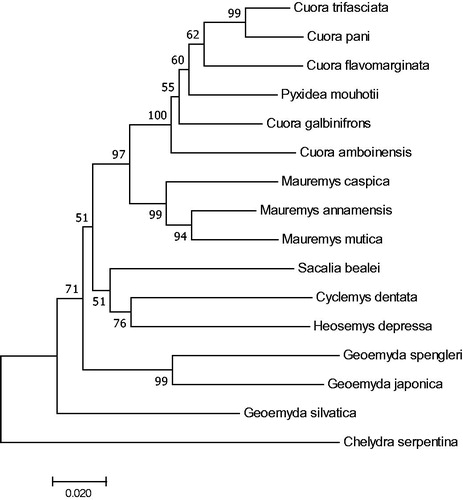Abstract
In this study, we determined the complete mitochondrial genome of Geoemyda spengleri. The genome was 17,448bp in length and contained 13 protein-coding genes, 22 transfer RNA genes, 2 ribosomal RNA genes, and 1 main non-coding regions. The overall base composition of G. spengleri is A 33.67%, T 27.64%, C 25.56%, and G 13.14%, with a highly A + T bias of 61.31%. Here, we describe a phylogenetic analysis of 16 species of Tesudines based on the complete mitochondrial genome, the result showed that G. japonica is most closely related to G. spengleri. This mitogenome sequence data would play an important role in the investigation of phylogenetic relationship, taxonomic resolution and phylogeography of the Tesudines.
Geoemyda spengleri, which belongs to Geoemyda, Batagurinae, Cryotodira, Reptilia. Geoemyda spengleri is a second-class protected wildlife in China, wildly distributed in Hunan, Guangdong, Guangxi, etc (Dong Citation2016). In order to provide useful information for the future research of genetic diversity and phylogenetic,we determined the complete mitochondrial genome of G. spengleri (GenBank accession number KU641028).
Geoemyda spengleri were obtained from the mountain forest. We took the muscle tissue from the severed tail and disinfected the turtle’s wound with alcohol. Initially, the turtle were identified based on both the morphologic features and the COX1 mitochondrial gene. Tissue samples for molecular analysis were reserved in 95% ethanol.Whole genomic DNA was extracted from muscle tissue of individual specimens using the phenol-chloroform method. Polymerase chain reaction (PCR) was performed. The PCR products were sequenced by Sangon Biotech, Shanghai, China.
Sequences were assembled using Generious 4.5.3 (http://www.geneious.com). BioEdit 7.0 (Hall, Citation1999) was used for sequence alignment. The neighbor-joining (NJ) (Saitou and Nei Citation1987) and maximum likelihood (ML) (Tamura et al. Citation2004) methods were used to construct the phylogenetic trees. The NJ trees were obtained with 10,000 bootstrap replications using MEGA7.0 (Kumar et al. Citation2016).
The complete mitochondrial genome of G. spengleri is 17,448bp in length and consists of 13 protein-coding genes, 22 transfer RNA genes (tRNA), 2 ribosomal RNA genes (rRNA) and 1 control regions (CR) (). The mitogenome base composition was A33.67%, T 27.64%, C25.56%, and G 13.14%, A + T content (61.31%) was much higher than the G + C content (38.69%), in common with other vertebrate mitogenomes. Except for eight tRNA (tRNASer, tRNAPro, tRNAGlu, tRNATyr, tRNACys, tRNAAsn, tRNAAla, tRNAGln) and the ND6 genes encoded on the L-strand, the other genes are encoded on the H-strand.Ten protein-coding genes(ND1, COX2, ATP8, ATP6, COX3, ND3, ND4L, ND4, ND5, CYTB) start with an ATG initiation codon, while ND2 uses ATA as the initiation codon, COX1 uses GTG as the initiation codon, and ND6 uses CCT as the initiation codon. Six protein-coding genes (COX2, ATP8, ATP6, ND4L, ND4 and ND5) use TAA as the termination codon; three protein-coding genes (ND1, ND2 and ND3) use TAG as the termination codon, while COX3 and ND6 share the termination codon CAT; COX1 use AGG as the termination codon, CYTB uses the incomplete stop codon T. The two ribosomal RNA genes, 12SrRNA (964 bp) is located between tRNAPhe and tRNAVal genes, and 16SrRNA (1681 bp) is located between tRNAVal and tRNALeu genes. The complete mitochondrial genome of G. spengleri has the only control region (1937 bp) gene located between tRNAPro and tRNAPhe.
Table 1. Mitochondrial genome characteristics of the Geoemyda spengleri.
In this study, Geoemyda japonica is most closely related to G. spengleri, Chelydra serpentina was placed at the most basal position forming an individual clade, while other species formed another large cluster. Cuora pani was grouped with Cuora trifasciata,Cuora flavomarginata, Pyxidea mouhotii, Cuora galbinifrons and Cuora amboinensis, Sacalia bealei, Heosemys depressa and Cyclemys dentata were clustered together,while the other three turtles were formed a clade (). Geoemyda spengleri is one of the endemic species in china. We expect that the present result will facilitate the further investigations of phylogenetic relationship,taxonomic resolution and phylogeography of the Tesudines.
Acknowledgements
Authors thank Du Weiguo, Jiang Lihua, Yang Yunxia, Zhao Dan for help with the experiments.
Disclosure statement
No potential conflict of interest was reported by the author(s).
Additional information
Funding
References
- Dong C. 2016. Morphological analysis of digestive system and feeding property of ground turtle. Sichuan Fauna. 35(5):741–747.
- Hall TA. 1999. BioEdit: a user-friendly biological sequence alignment editor and analysis program for Windows 95/98/NT. Nucleic Acids Symp Ser. 41:95–98.
- Kumar S, Stecher G, Tamura K. 2016. MEGA7: molecular evolutionary genetics analysis version 7.0 for bigger datasets. Mol Biol Evol. 33(7):1870–1874.
- Saitou N, Nei M. 1987. The neighbor-joining method: a new method for reconstructing phylogenetic trees. Mol Biol Evol. 4(4):406–425.
- Tamura K, Nei M, Kumar S. 2004. Prospects for inferring very large phylogenies by using the neighbor-joining method. Proc Natl Acad Sci USA. 101(30):11030–11035.

